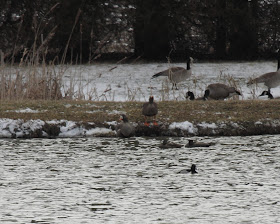If you aren't using eBird yet, you might find this presentation I recently did helpful.
First up, the most interesting stat (in my opinion) is the number of checklists submitted per year. The growth of eBird in Ontario continues to be staggering:
 |
| Ontario eBird checklist submissions per year |
And amazingly, we are already (as of March 29, 2013) up to 37,097 for this year! February and March 2013 have had the most checklist submissions yet! Viewing the same data, but per month reveals the not surprising trend through the year where birders are out most in spring and fall:
 |
| Ontario eBird checklist submissions per month |
The geographic distribution of observations has stabilized a little bit now, with the only real surprises (in my opinion) being a) Northumberland at number 1 (although that is explained by about half of those are from the upload of the Northumberland County Bird Database); b) the relatively poor showing by Hamilton and Halton at spot 14 and 15; c) the strength of Peterborough; and d) the relatively poor showing by Middlesex at spot number 30. The full listing is in table 1:
Table 1. Total number of eBird observations submitted for each Ontario "county" all time, sorted from most to least observations.
| County | observations |
| Northumberland | 315022 |
| Essex | 281163 |
| Toronto | 241902 |
| Ottawa | 190418 |
| Norfolk | 187778 |
| Durham | 133205 |
| Peterborough | 112312 |
| Waterloo | 106083 |
| Niagara | 98309 |
| Peel | 92268 |
| Frontenac | 89222 |
| Stormont, Dundas and Glengarry | 88317 |
| Leeds and Grenville | 87101 |
| Hamilton | 68451 |
| Halton | 67575 |
| Wellington | 66281 |
| Chatham-Kent | 63487 |
| Nipissing | 60775 |
| Elgin | 60589 |
| Haldimand | 53290 |
| Perth | 50552 |
| Cochrane | 50208 |
| Bruce | 48034 |
| Algoma | 46072 |
| Kawartha Lakes | 44594 |
| Lambton | 43062 |
| Lennox and Addington | 42393 |
| Prince Edward | 41914 |
| Thunder Bay | 38495 |
| Middlesex | 33599 |
| Simcoe | 31504 |
| Rainy River | 29984 |
| Kenora | 25639 |
| Prescott and Russell | 20951 |
| Muskoka | 20510 |
| York | 20413 |
| Renfrew | 17695 |
| Hastings | 17181 |
| Oxford | 15823 |
| Timiskaming | 14852 |
| Manitoulin | 14731 |
| Huron | 12293 |
| Lanark | 10603 |
| Parry Sound | 8838 |
| Grey | 8355 |
| Brant | 8169 |
| Haliburton | 8040 |
| Dufferin | 7330 |
| Sudbury | 6599 |
| Greater Sudbury | 5847 |
The Ontario eBird user base also continues to grow. To date we have received checklists from an impressive 5985 different users! I have ranked everyone by the number of observations (each species/checklist combination counts as an observation) - if you want to know where you fit on that list or your total number of eBird observations let me know! Personally, I've submitted just shy of 83,000 observations!
 |
| One of my most recent eBird observations: the Western Grebe in Toronto |
And finally, eBird has records of 679 species, forms, spuhs and slashes (read this article to understand what that means!) in the public database. The top 25 species reported are listed in Table 2:
Table 2: Top 25 species reported to eBird in Ontario.
| Species | Observations |
| Black-capped Chickadee | 94424 |
| American Crow | 85632 |
| Mourning Dove | 75208 |
| American Robin | 73471 |
| Blue Jay | 71894 |
| American Goldfinch | 71810 |
| Canada Goose | 70413 |
| Ring-billed Gull | 68540 |
| European Starling | 66628 |
| Mallard | 65345 |
| Northern Cardinal | 61462 |
| Red-winged Blackbird | 57064 |
| Song Sparrow | 52600 |
| Common Grackle | 50402 |
| Downy Woodpecker | 49976 |
| House Sparrow | 46403 |
| Dark-eyed Junco | 41740 |
| White-breasted Nuthatch | 38884 |
| Herring Gull | 38345 |
| Rock Pigeon | 33748 |
| Northern Flicker | 30164 |
| Red-tailed Hawk | 29864 |
| House Finch | 29216 |
| Great Blue Heron | 29139 |
That's all for now!


























